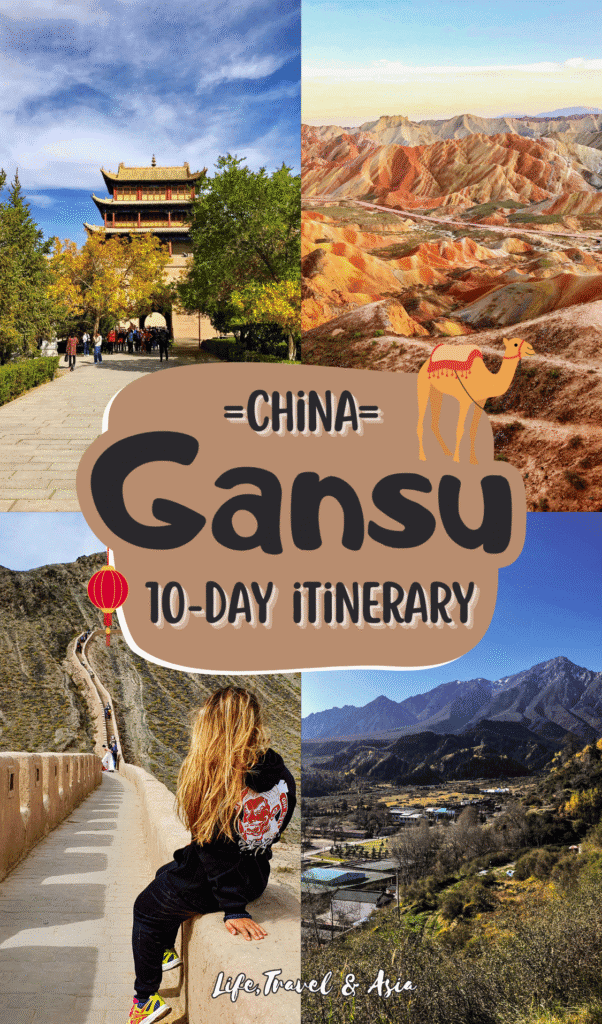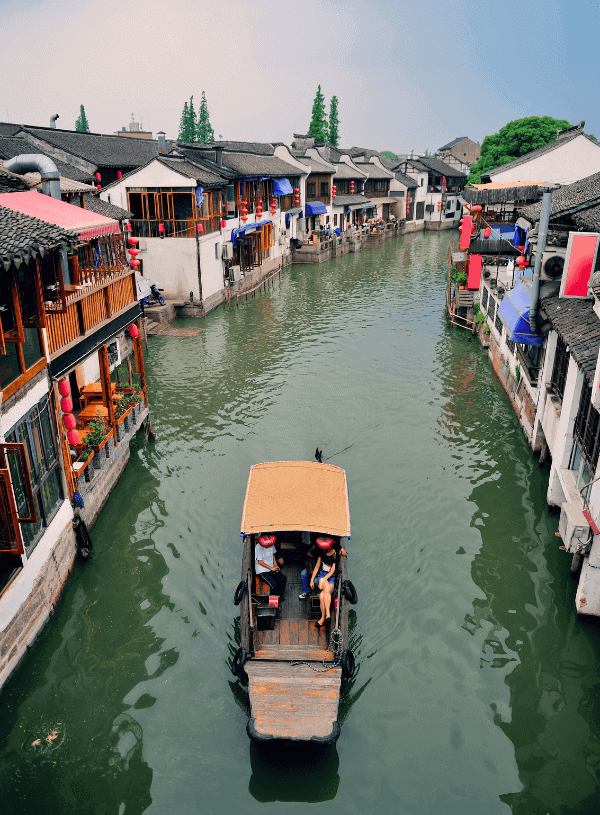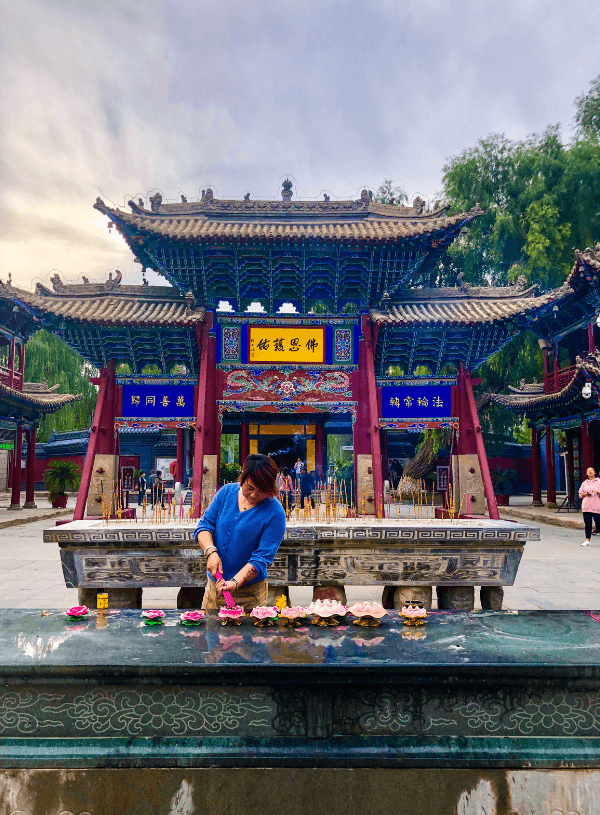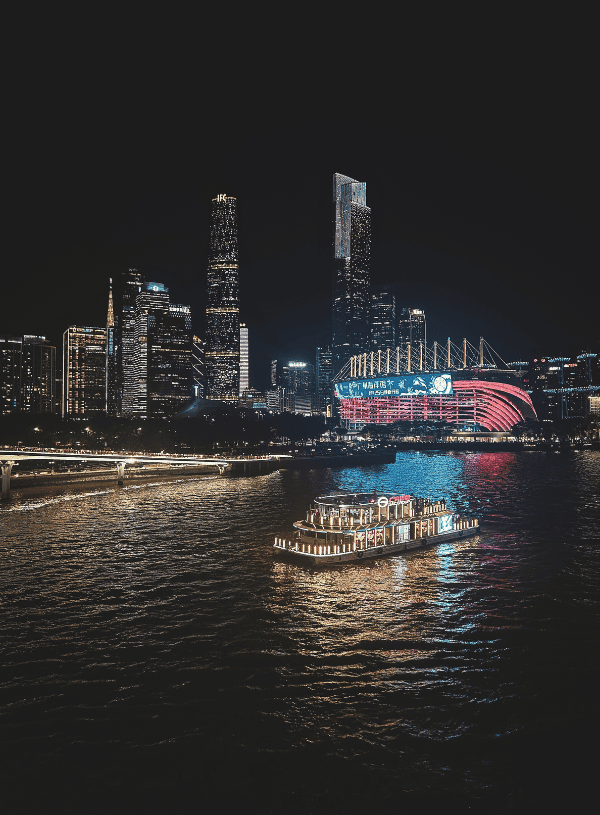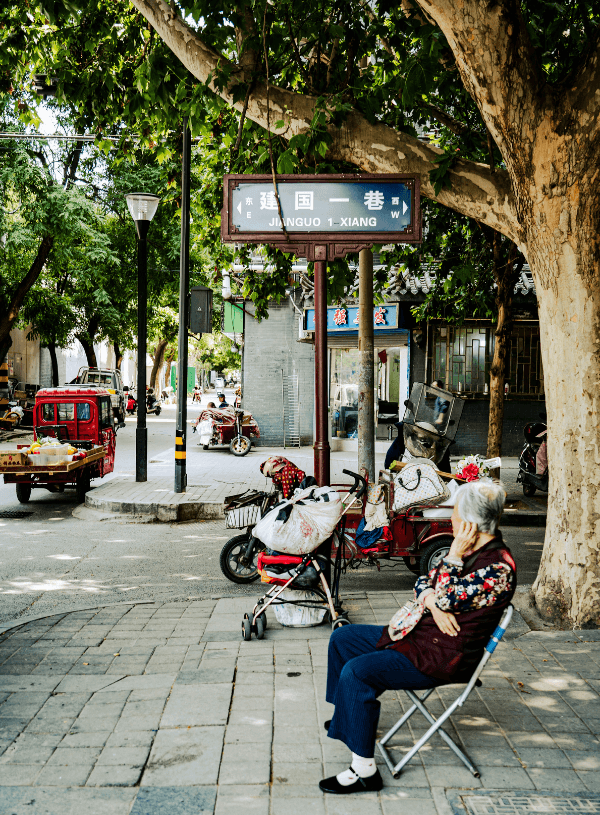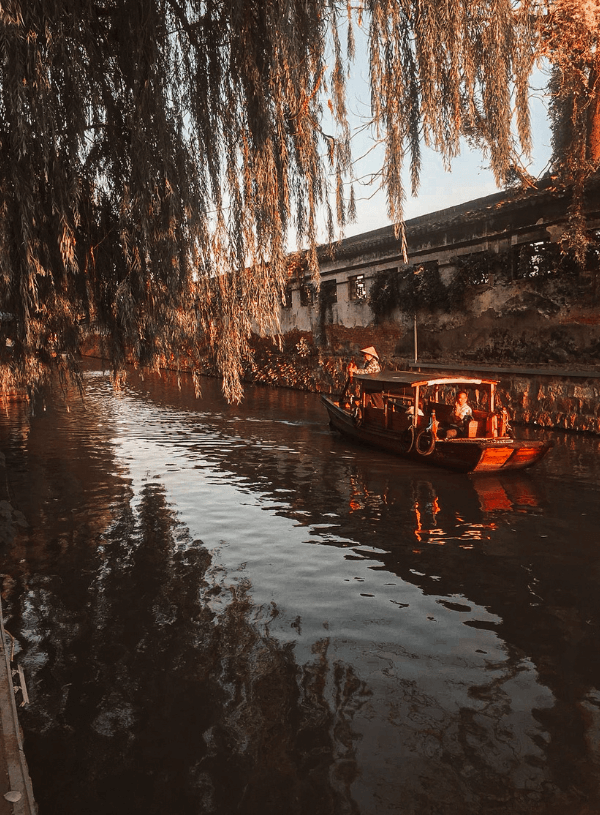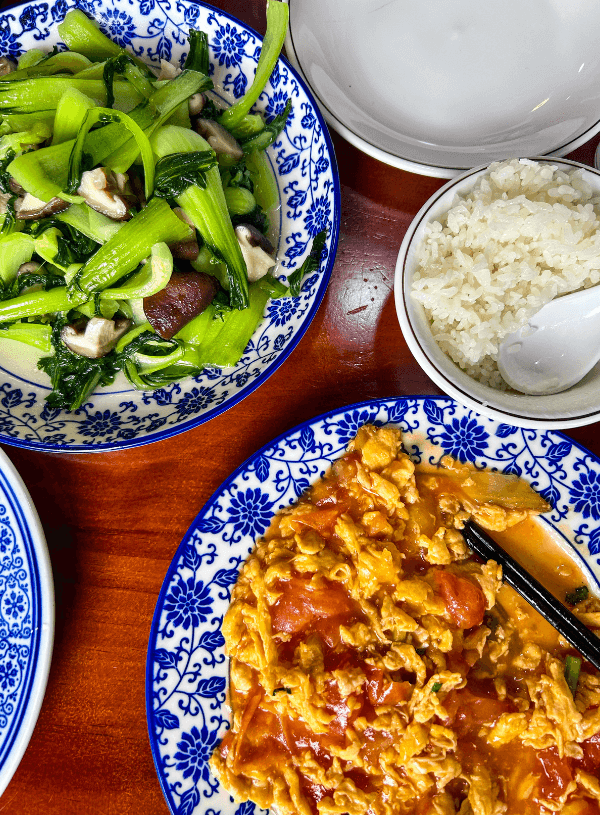7-Day Gansu Itinerary: Off the Beaten Path Journey in China
Last Updated on November 18, 2025
Are you finally ready to go off the beaten path in China and explore one of the most interesting areas of the country?
Gansu Province, located in northwest China, is far from a hidden gem for locals. Still, it remains largely overlooked by Western travelers and is one of the country’s most underrated regions.
Home to the Hexi Corridor — the most important section of the Ancient Silk Road within China — this area was also where the Great Wall was extended, with forts and passes built deep into the surrounding deserts. Many of these historic sites can still be visited today.
If you’re picturing yourself hiking dunes at sunset and exploring mystical Buddhist temples perched on dramatic cliffs, this Gansu itinerary is for you.
In this travel guide, I will share all about my 7-day itinerary: from the best things to do to how to handle transportation and logistics.
This article may contain affiliate links. This means that if you purchase through one of the links, I may be paid a small commission at no extra cost to you. Thank you for supporting the blog and allowing me to keep sharing meaningful travel experiences with you.
Don’t have time now?📌 Save it for later!
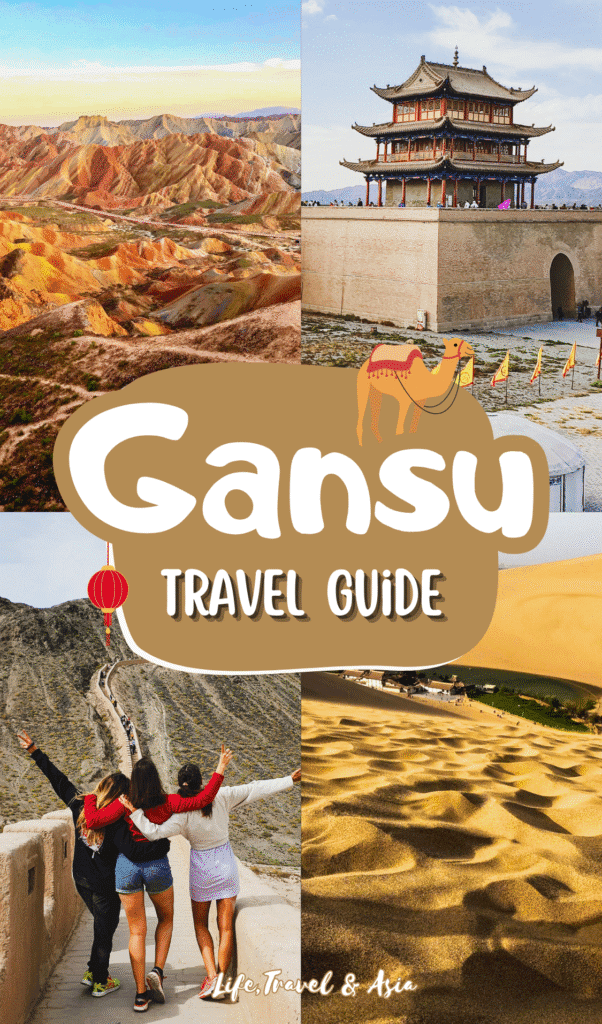
Is The Gansu Province Worth Visiting?
Absolutely — no doubt about it. The Gansu region shows you a completely different side of China.
If you’ve already been in China and visited the major cities, this will feel like another country. Forget futuristic skylines and efficient subways.
Here it’s all about wild landscapes, remote villages, and raw, untouched nature. The south is mountainous, the north is flat and dry, and part of the Gobi Desert is in this region.
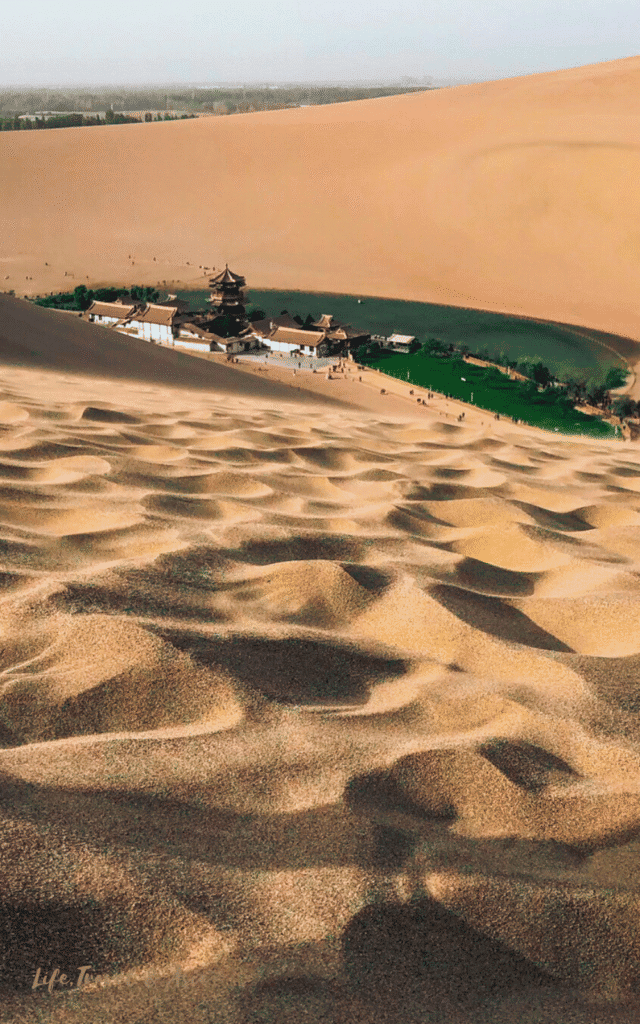
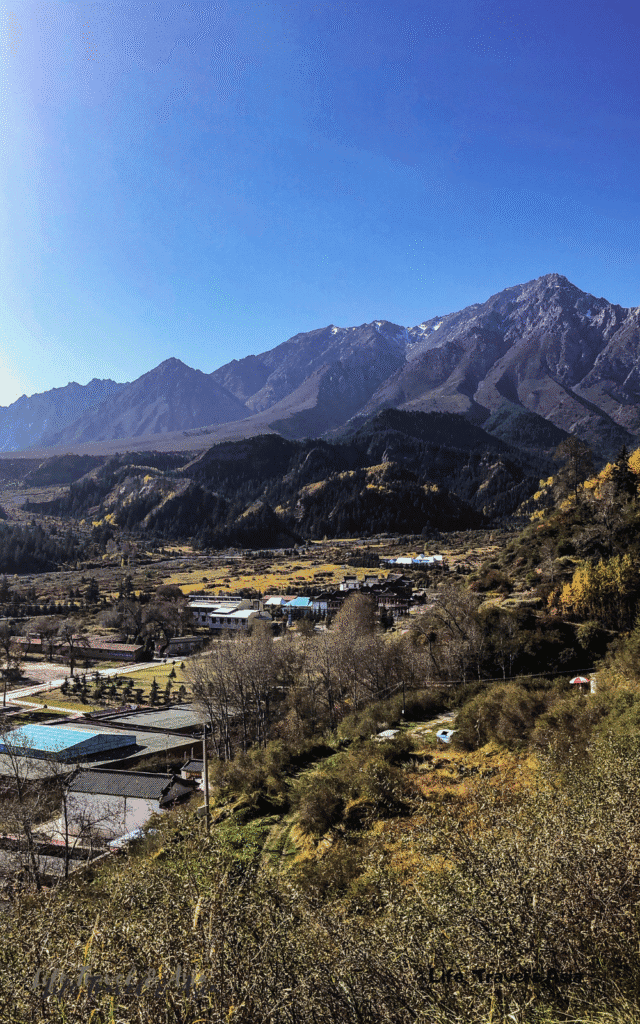
Gansu is also where the Ancient Silk Road passed through, along what’s known as the Hexi Corridor. Starting in 130 BC, thousands of merchants, travelers, and wanderers crossed this route, traded not just goods but also ideas, religions, and art.
It’s thanks to this mix that Chinese Buddhist art was influenced by Indian, Persian, and Greek styles, as evident today in the carvings of the Longmen and Datong caves.
Along this ancient route, the flow of commerce left behind military forts, sections of the Great Wall, and trading towns that still hold onto their fascinating historical charm.
And beyond all that history, the landscapes here are some of the most beautiful and unexpected in China. You’ll find Tibetan nomads, dramatic deserts, colorful mountains, and peaceful villages.
Planning Your Gansu Itinerary
1. Key Things to Know
2. Best Time to Visit Gansu
The best times to visit the Gansu region are early fall (September to October) and spring (March to May).
I visited Gansu in early fall, the first week of October (Yes, it’s the Golden Week, but I had no choice), and the weather was perfect. It was a bit chilly at night but warm and sunny during the day, ideal for exploring without overheating.
I’d avoid the peak of summer (July and August), as it can get extremely hot and uncomfortable, especially in the desert areas. Winter, on the other hand, brings freezing temperatures and heavy snow in the mountains, which can make travel tricky.
3. How Many Days in Gansu
Gansu is much bigger than it looks, and I honestly think 7 days is the bare minimum to see the major sights and still have time to travel between cities by high-speed train.
Even with a week, you won’t be able to see everything…there’s just too much. That’s why I’ll add some extra suggestions at the end of this post in case you can extend your Gansu Itinerary to 14 days.
In my case, I only had 7 days to dedicate to this trip, and I made it work. But if you have more time, don’t worry, you definitely won’t get bored. Gansu has plenty to offer.
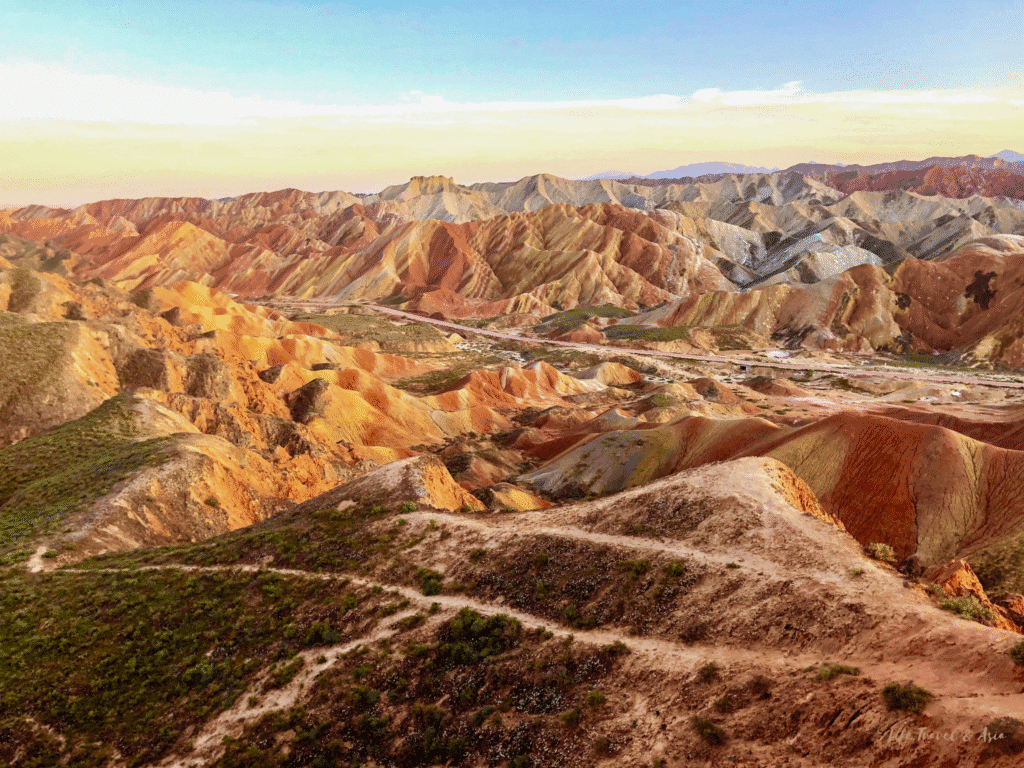
4. How To Get To The Gansu Province
Getting to Gansu is not one of the challenges you’ll face. Several smaller airports in the region handle domestic flights. However, flight frequency varies by season. Your best options are Lanzhou and Xi’an.
- Lanzhou: The region’s largest city, located in the south. Many flights come and go on a daily basis from major Chinese cities. It’s usually the most convenient option if you’re flying in from elsewhere in China.
- Xi’an, even though it’s technically not in Gansu, is closely tied to the Ancient Silk Road, and if you’re already heading to Northwest China, it would be a shame not to stop by.
5. How to Get Around in Gansu
1. Between Cities
Getting around the region is easier than you might think. All the main cities in Gansu lie along the route from Xi’an to Xinjiang Province and are well connected by high-speed trains.
I highly recommend booking your tickets in advance through Trip.com. It’s the easiest and most reliable way to handle it.
Buying tickets directly at the station can be tricky if you don’t speak Chinese, and trains sometimes sell out, especially during holidays.
2. Around The Cities
Here comes the tricky part. The only subway in the entire Gansu region is in Lanzhou (which, to be honest, is also the least interesting city in the province).
This means that to reach most of the sights, many of which are in remote natural areas, you’ll need to rely on buses, taxis, or private transport.
Each option has its pros and cons, and navigating it all can be a bit of a challenge, especially if you don’t speak Chinese.
I’ll break down all the transportation tips in this guide to help you figure out what works best. In every section of the itinerary, I will include options to book transportation with tour operators, if available.
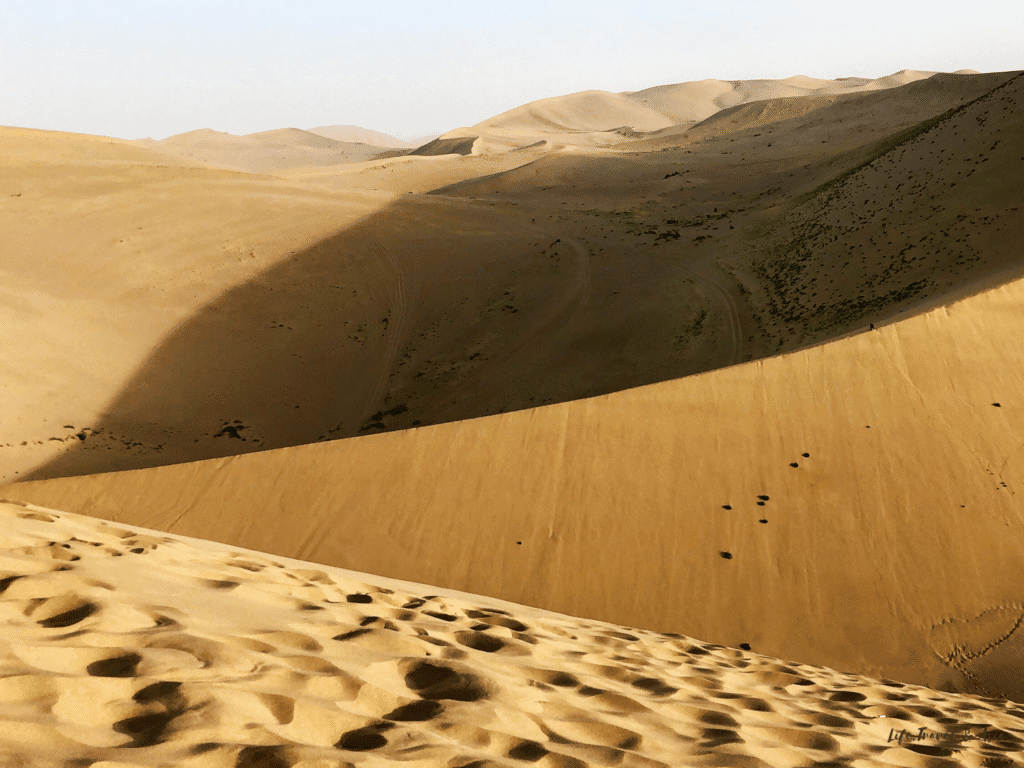
Buses
Buses are sometimes the only option to reach sights (not always), and here are some tips to navigate the bus system in Chinese remote areas:
- Use apps like Rome2Rio or the Maps app on iPhone to find the correct bus number to reach your destination.
- Always double-check with your accommodation and confirm with the driver (mention the name of the city or destination) to ensure the bus is actually going to the right place.
- Consider travel times: Buses are cheaper, but they take longer than taxis, which can be a downside if you’re short on time.
Taxis
This is how we handled transportation with taxis during our Gansu itinerary: whether we already knew a taxi driver or just met one on the spot, we’d ask if he was available to stay with us for the whole day and take us around.
We agreed on a price for the day, and we were set. That worked well for us because we spoke Chinese and could communicate easily.
Even if you don’t speak Chinese, it’s usually easy to find a taxi to head somewhere. The real challenge is finding a cab that takes you back, especially in remote areas. Even Didi (the Chinese version of Uber), doesn’t work in most remote areas.
If you want to use taxis to get around, one of the best solutions is to ask your accommodation to help arrange transportation. Many places are happy to assist, especially if you’re staying in local guesthouses or small hotels. They often have their own contacts and are familiar with the area.
6. Where to Stay During Your Gansu Itinerary
Here are some places I recommend staying in Xi’an, Zhangye, Jiayuguan, and Dunhuang, based on my own experience and recommendations from friends.
- Xi’an: Xi’an Bell Tower Huimin Street and Fanjian Inn Xi’an Drum Tower are great options. Located in the heart of the city, they have a great local vibe and easy access to major sights.
- Zhangye: Zhangye Douya Youth Hostel is a budget-friendly and comfortable option. The Silk Road Travellers Hostel is closer to the Rainbow Mountains and the staff speaks English!
- Jiayuguan: Yangguan Guren Youth Hostel is a hostel near the Great Wall, and the Fort, Huili Business Apartment is conveniently located near the Jiayuguan railway station.
- Dunhuang: Dunhuang Mountian Spring Hostel is close to the Crescent Moon Lake and the desert dunes. All Seasons Hotel is close to the city center and offers excellent services!
Heads-Up!
No matter which hostel or hotel you book, always get in touch with them to confirm your reservation and mention that you’re a foreigner. Trust me — you don’t want to end up like me and my friends, discovering that our hostel didn’t exist or being randomly moved to a completely different one because the original place didn’t accept foreigners. This kind of thing can happen, especially in remote areas. Always double-check!
7. Packing Tips
I’d honestly stick to a simple rule when packing for Gansu: pack light. This was the first time in my life I traveled with just a 30L backpack for a 7-day trip, and let me tell you…I was constantly washing socks.
Think of this tour as a proper backpacking trip. There won’t be clubs or fancy bars to dress up for. Maybe just a couple of chill nights at the hostel, but nothing that requires more than comfy clothes.
Sometimes, we even had to carry our backpacks with us all day because we were catching a train right after visiting a site. So I kept it simple, and I suggest you do the same. This was my packing list:
- 30-40L Backpack
- Small Crosswaist Purse
- One pair of hiking shoes (that I had on)
- T-shirts and Simple Leggings
- One hoodie
- 1 Rain jacket
- 1 Microfiber Towel
- Paper Towel or Tissues (always bring them with you in China)
- Sanitizing hand gel and wipes
- Charger, power adapter, small power bank, sunglasses, and umbrella
- Small beauty case with makeup, hair, and skincare products
8. DIY Trip VS Group Tour in Gansu
Gansu isn’t the easiest province to travel around: places are a bit more remote, and most accommodations and sights aren’t super used to foreign travelers yet. That’s why joining a group tour can be a good idea, especially if you don’t want to deal with all the logistics.
However, if you still want to keep some flexibility (I completely understand!), a great option is to plan your route, book your hotels and trains, and then join day trips for those harder-to-reach spots. That way, you get the best of both worlds: less hassle, but still your adventure.
If you’re looking for more details on traveling to China, my China travel guide could be precisely what you need. You’ll find everything from visa requirements and the best times to travel to tips on language, etiquette, and so much more.
7-Day Gansu Itinerary: From Xi’an To Dunhuang
This is the exact Gansu itinerary I followed in the fall of 2019, to be precise, at the beginning of October. It was the very first time I ventured off the beaten path in China, and it turned out to be one of the most fun and interesting trips I’ve ever taken.
I started in Xi’an, where I was living at the time, and with a group of friends, we made our way west along the Ancient Silk Road, all the way to Dunhuang, which was once the last oasis before crossing into the deserts. Along the way, we stopped in Zhangye, Jiayuguan, Dunhuang, and finally Lanzhou (just for one day at the end).
This was the moment I fell in love with China’s wild, untouched side: the vast deserts, Tibetan villages, and landscapes that feel like a completely different world from the busy cities in the east.
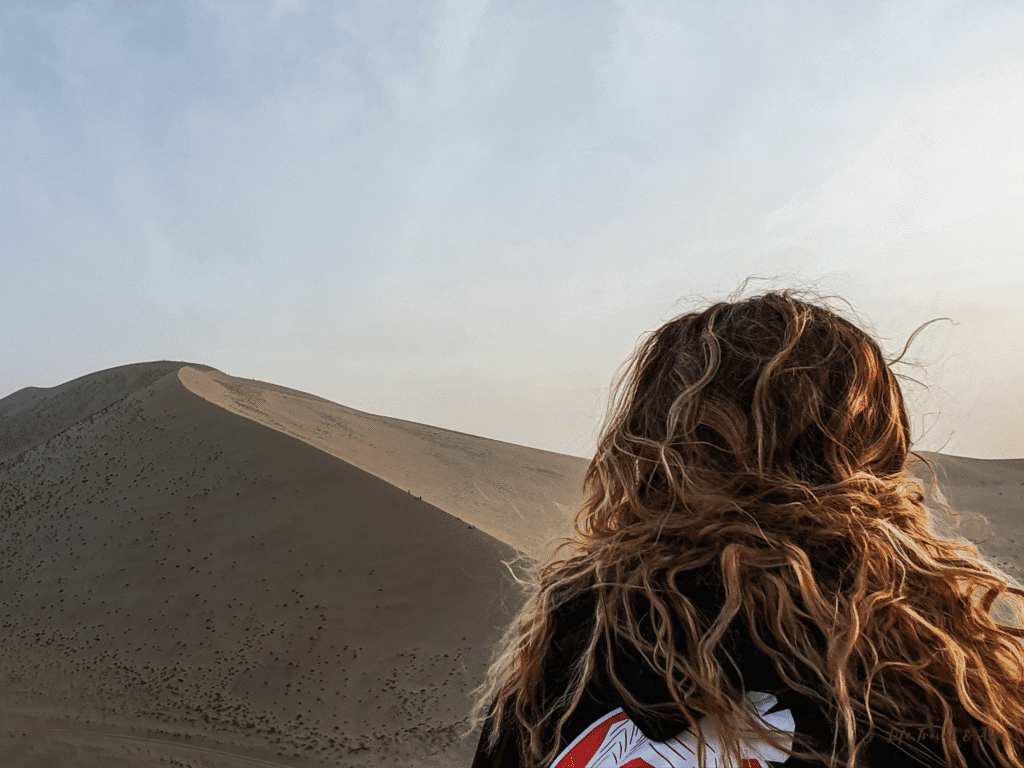
If you’re looking to plan a similar itinerary, I can assure you it’s enough time to see the main Gansu tourist attractions, while still allowing for some downtime in each city.
I’ll also share a few places I couldn’t visit due to time, but that would be amazing to include if you have extra days.
We used high-speed trains for all long-distance travel (which I highly recommend), with the longest ride being from Xi’an to Zhangye (about 7 hours).
Here’s a quick rundown of the itinerary:
- Xi’an (Day 1-2), including (maybe) a trip to the Terracotta Warriors or to Mount Hua
- Zhangye (Day 3-4)
- Jiayuguan (Day 5)
- Dunhuang (Day 6-7)
If you have only 7 days available and want to spend more time in Gansu, you can:
- Skip Xi’an, land in Lanzhou, and add the Labrang Monastery in Xiahe and the Maiji Shan grottoes in Tianshui to your Gansu itinerary.
Alternatively, if you have more than 7 days available, consider traveling from Xi’an to Lanzhou and adding these stops before heading to Zhangye.
Xi’an: The Start of The Ancient Silk Road
Xi’an is the capital of the Shaanxi Province, not technically in Gansu, but a must-visit as the starting point of the Ancient Silk Road. This city is so rich in history, and you can easily explore it in two days.
The main sights are surrounded by one of the best-preserved City Walls in China, and you can even bike along the top for the best views of the city.
You can start at the Drum & Bell Tower, right in the center of the walled area, and then walk to the vibrant Muslim Quarter, where Islamic culture meets Chinese tradition, a legacy of the Silk Road.

Here, you should check out the Great Mosque, hidden among street food stalls.
On day 2, you can take a half-day trip to the iconic Terracotta Army, one of China’s most famous UNESCO sites, or plan a hike to one of the sacred mountains for Taoism: Mount Hua, before catching your high-speed train from Xi’an North Station to Zhangye.
For a deeper dive, check out my 2-day Xi’an itinerary and my guide to 13 amazing things to do in Xi’an. They’ll help you make the most of this stop in this gem of a city.
Tickets & Tours in Xi’an
Zhangye: Rainbow Mountains & Buddhist Temples
🚌 How to get to Zhangye: from Xian North Railway Station to Zhangye West. It will take a maximum of 7 hours, depending on the train you choose. Ideally, select a train that arrives in Zhangye in the late evening, so that you can start your visits in the morning.
Tickets & Tours in Zhangye
Day 3: Rainbow Mountains & Mati Temple
Rainbow Mountains (Danxia National Geopark)
🚌 How to get there: The best way to reach the Danxia National Geopark is by taxi. From downtown Zhangye, the journey lasts around 30 minutes.
The pictures of the Rainbow Mountains in Zhangye speak for themselves. This is one of the most breathtaking places I’ve ever seen in China and likely what Gansu is known for.
The mix of orange, red, yellow, and brown stripes was formed over millions of years by layers of sandstone and minerals. Seeing it in person honestly feels surreal.
To make the most of your visit, I strongly recommend arriving early in the morning (the park opens at 6 am) for the best lighting and to avoid the crowds.
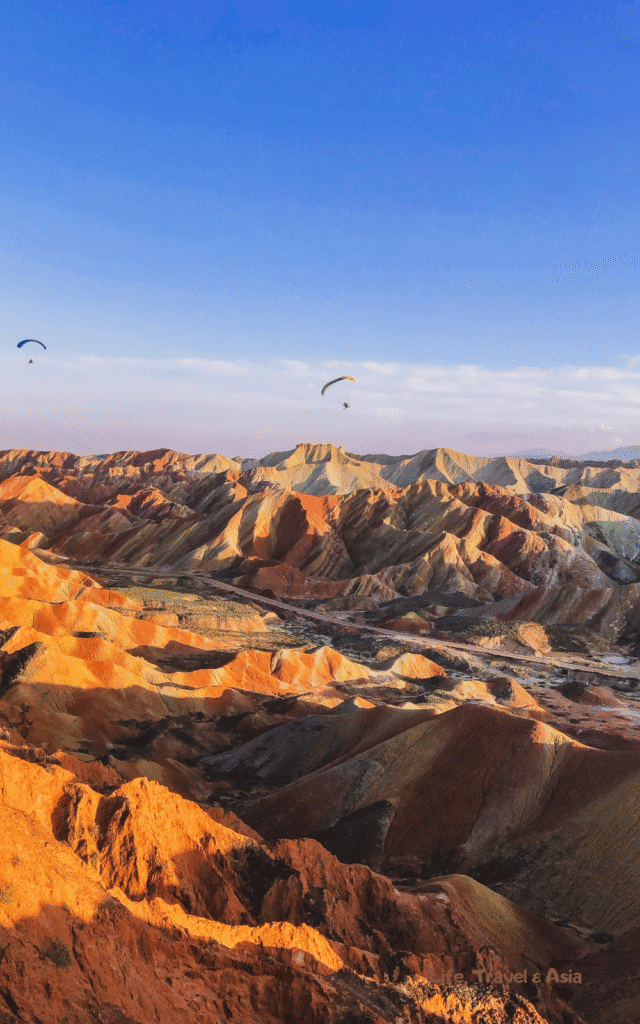
Keep in mind you can’t wander freely around the mountains, you’ll follow a shuttle route with stops at different observation decks. My personal favorites were the first, fourth, and fifth decks — they offer the best panoramic views.
If you’re planning a visit to the Rainbow Mountains, don’t miss my complete guide to Zhangye Danxia Geological Park.
Mati Temple
🚌 How to get there: The best way to reach the Mati Temple is by taxi. From the Danxia National Geopark, the journey lasts around one and a half hours.
Calling Matisi “just a temple” really doesn’t do it justice.
This site spans over 30 kilometers and is home to seven distinct grotto groups carved into the side of a mountain. When I arrived, I immediately thought, “This feels like a completely different China.” It’s peaceful, quiet, and feels like you’ve stumbled into a hidden mountain retreat.
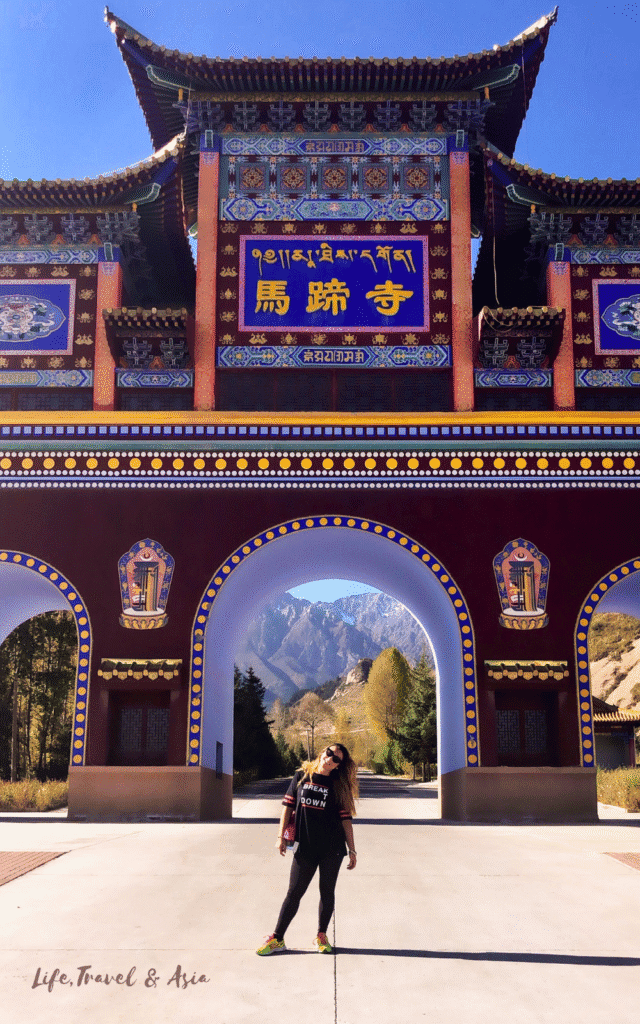
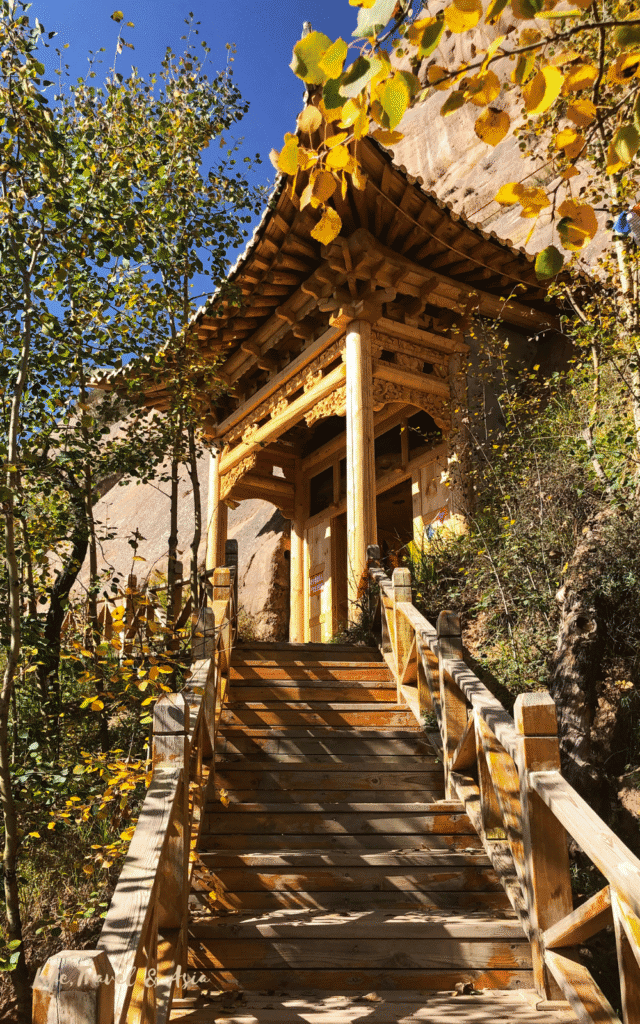
One of the first things you’ll spot is the horseshoe-shaped pattern of windows etched into the cliffs. The legend has it that a flying horse left a hoof print on the rock, creating space for the caves.
You’ll explore the site through staircases, wooden walkways, and narrow passages leading from one grotto to the next.
Inside, you’ll find colorful murals, Buddha statues, and beautifully preserved carvings directly in the rock. Honestly, this is one of the most beautiful Buddhist sites I’ve ever been to!
You can purchase your ticket here. There are multiple ticket options, including some special caves that are excluded from the basic ticket.
Heads-Up!
There’s no public transportation available to reach either the Rainbow Mountains or Mati Temple, so you’ll need to plan ahead.
You have two main options: the first is to ask your accommodation to help you arrange a private driver for the day.
The second (and easiest) option is to book a guided day tour that includes both stops. These tours usually cover hotel pick-up and drop-off, entrance tickets, and a local guide who can share insights along the way. Here’s a day tour including exactly these two sights.
Day 4: Dafo (The Great Buddha) Temple & Train to Jiayuguan
🚌 How to get there: The temple is in the city, so you can easily walk there from your hotel.
The Great Buddha Temple (Dafo Si) is a must-see while in Zhangye. Built during the Western Xia dynasty around 1098, it’s home to one of China’s largest reclining Buddha statues (around 35 meters long).
The statue is housed in a huge wooden structure, one of the oldest surviving in the region.
Beyond the main hall, the temple grounds offer more to explore: exhibition rooms filled with Buddhist artifacts, sculptures, and a peaceful courtyard where you can observe locals praying and lighting incense.
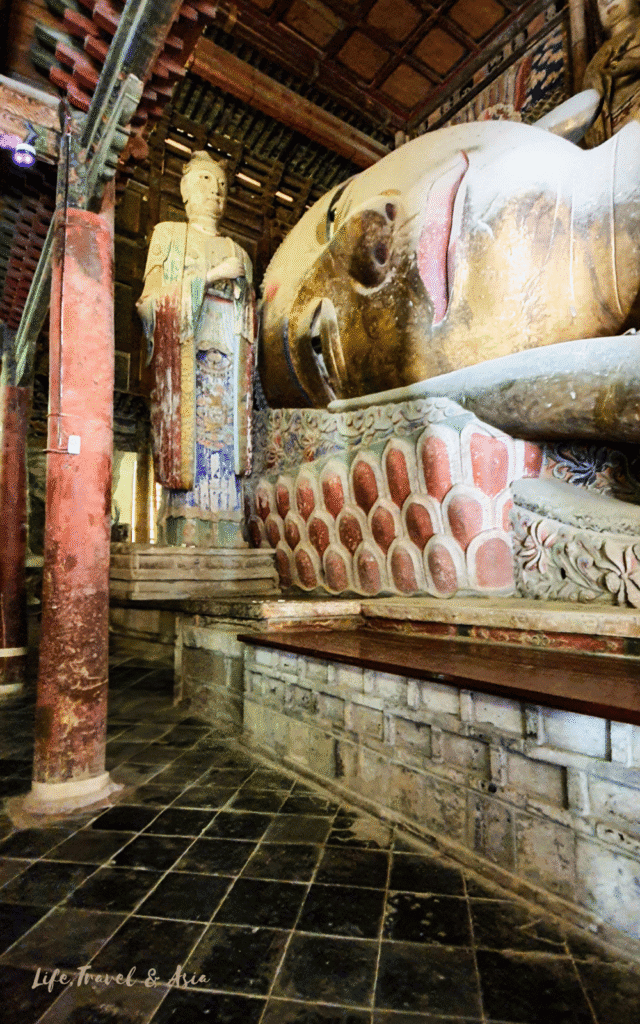
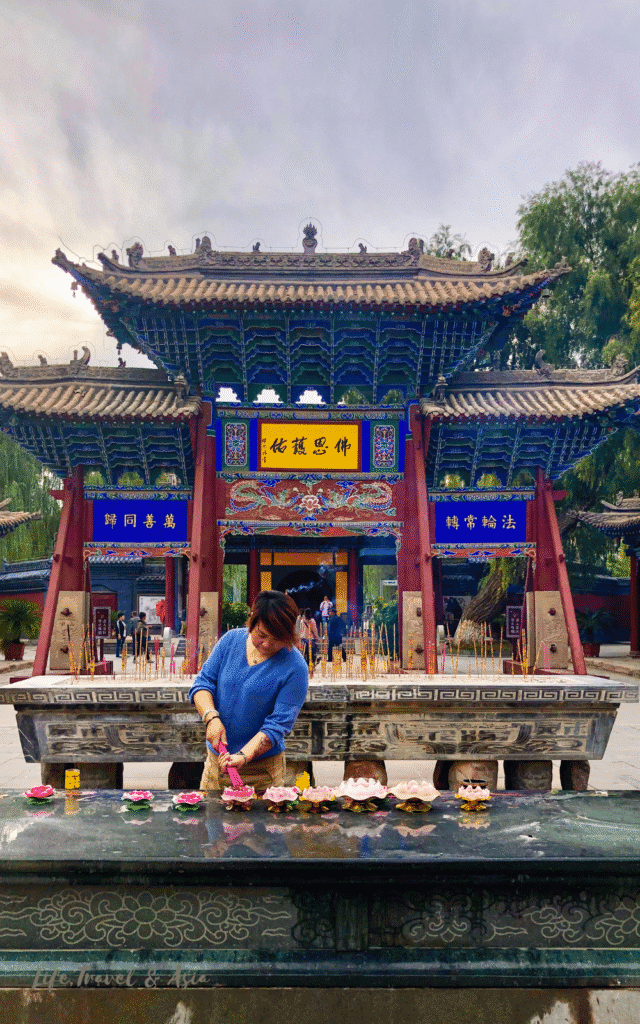
Don’t miss the white clay stupa at the back of the complex. You can directly buy your ticket at the entrance.
After your visit, you can take some time to wander around Zhangye’s relaxed vibe and plan to catch your train in the early afternoon.
For lunch, you can stop by East Minzhu Street, where you’ll find the best street food in Zhangye. Here you’ll find all the local specialties and snacks to try.
I suggest you take the train to Jiayuguan in the afternoon, so you have time to settle in and explore the city in the evening. Plan your visit to Jiayuguan for the following day.
Day 5 in Jiayuguan: Fort & The Western Great Wall
🚌 How to get to Jiayuguan: You can take a high-speed train from Zhangye West Train Station to Jiayuguan South Train Station. It will take about 1.5 hours.
To get to the Jiayu Pass and the nearby Great Wall Section, I suggest taking a taxi from your hotel. It’s not excessively far, so you’ll be able to get a cab back. You can purchase tickets on site.
Jiayuguan was once the last stronghold of the Chinese Empire. The Jiayuguan Fort marked the very end of the Great Wall and the start of the unknown world. You really feel it when you’re standing there, surrounded by the Qilian and Hei Mountains.
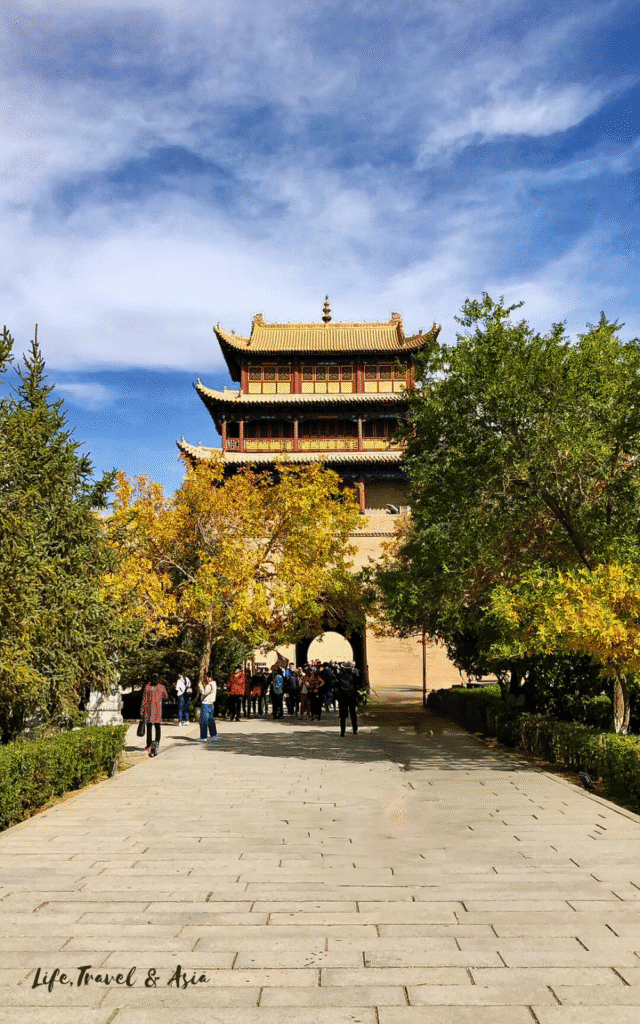
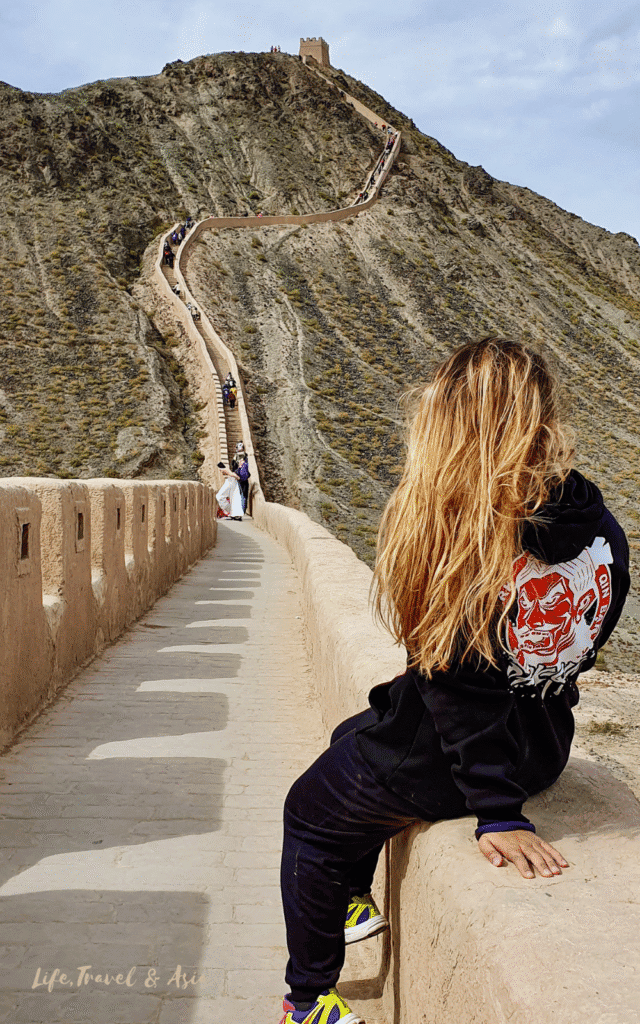
The city itself doesn’t have much going on, but the fort and the nearby section of the Great Wall are absolutely worth it.
The fort is well-preserved, and walking along its walls gives you great views of the desert and mountains. It feels like stepping into a scene from a far-west movie (in this case, it’s the far-east, I would say).
Right outside the fort is one of the earliest built sections of the Great Wall.
The climb up is steep, but the views are stunning. You can definitely see both the fort and the Wall in one day—just be sure to keep track of time if you have a train to catch afterward.
Day 6 in Dunhuang: Buddhist Grottoes & Sand Dunes
🚌 How to get to Dunhuang: You can take a high-speed train from Jiayuguan South Train Station to Dunhuang. The fastest trains will take around three hours. I would ensure to arrive in Dunhuang on the evening of Day 5.
Dunhuang is hands down one of the most special places I have visited in China. This little desert town sits right at the edge of an oasis. It’s super clean, quiet, and way more charming than you’d expect from such a remote location.
The city itself has a cool, laid-back vibe with night markets, backpacker hostels, and chill cafés.
But what makes Dunhuang unforgettable are its two main sights: the Mogao Grottoes and the Singing Sand Dunes.
One of the most special things about Dunhuang is how the city streets suddenly give way to desert dunes. One moment you’re surrounded by shops and traffic, and the next, you’re staring at endless sand.
Mogao Grottoes
🚌 How to get there: You can take a taxi from Dunhuang to the Mogao Caves, a half-hour ride. You can also plan to take the bus from Dunhuang Bus Station, which takes 40 minutes.
Book Your Tickets in Advance!
Daily entrances to the Mogao Grottoes are limited, and there are several ticket options available—including a specific one for foreigners. To avoid any issues or last-minute stress at the entrance, make sure to book your ticket in advance.
The Mogao Grottoes are considered one of the most important Buddhist art sites in the world. During the Tang dynasty, the area was home to 18 monasteries and over 1,000 monks, artists, and calligraphers.
You can only imagine the knowledge, culture, and creativity exchanged within these caves, making it the perfect place for art to flourish.
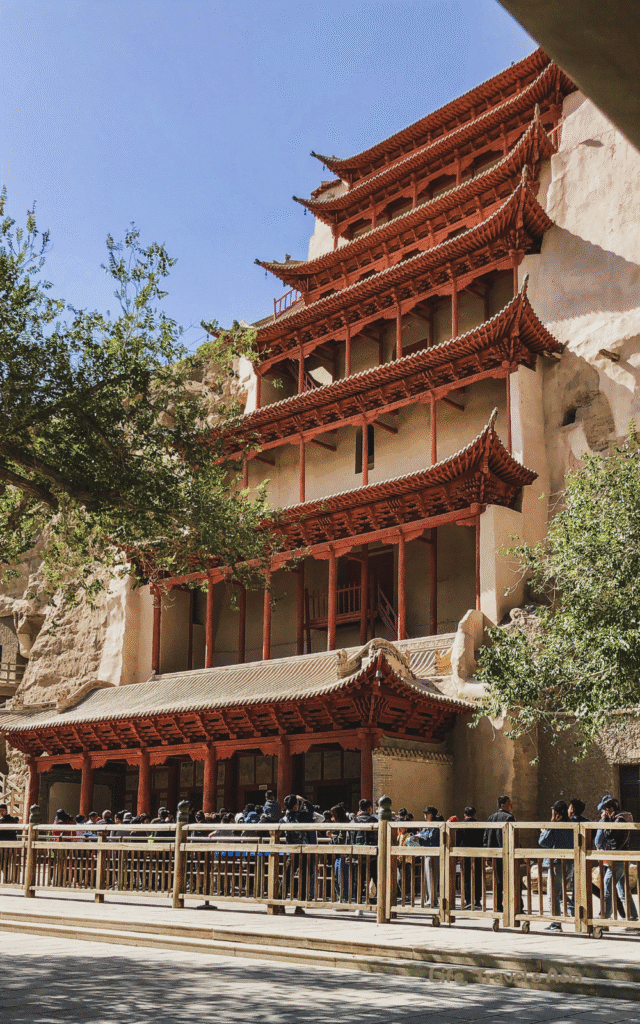
Today, the site is highly protected, and daily entrances are limited. The best way to visit is by booking your ticket in advance. The foreign traveler’s ticket is the $35 one.
Unfortunately, it’s not possible to explore the caves on your own, but the guided experience includes highlights like the Library Cave and Cave 96, home to two incredible 35-meter-tall Buddha statues.
Singing Sand Dunes & Moon Crescent Lake
🚌 How to get there: The dunes are very close to the city of Dunhuang. You can easily reach them by taxi. You can also hop on bus #3 from the city.
Just 6 km south of Dunhuang lies the desert landscape and Crescent Moon Lake. As you head toward the dunes, it feels like the city suddenly dissolves into an endless sea of sand.

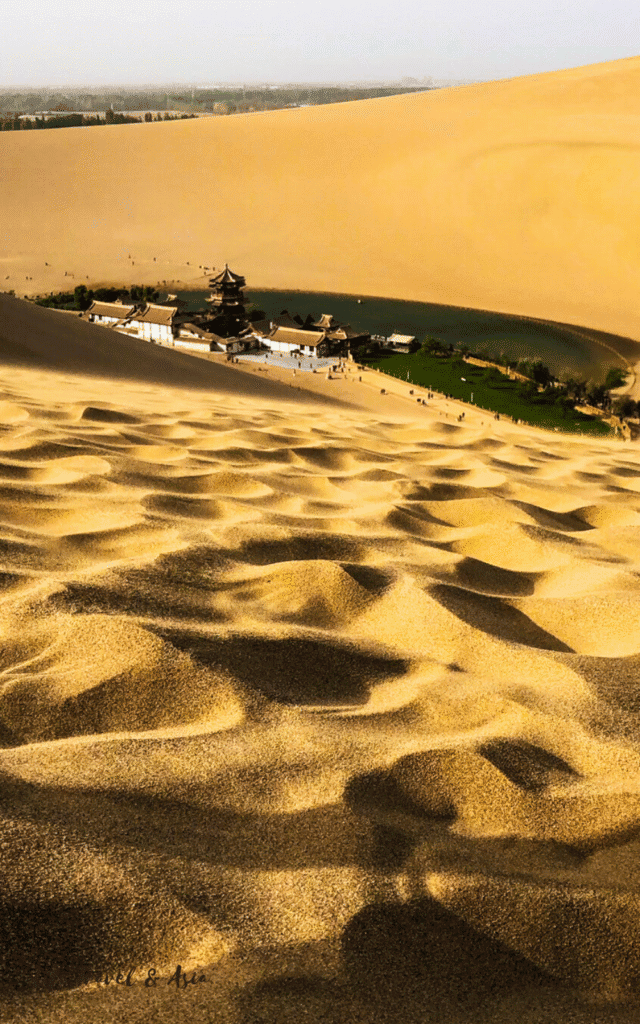
Climbing the dunes is a bit of a workout, but it’s so worth it. From the top, you’re rewarded with the best view: on one side, the peaceful Crescent Moon Lake below you like a perfect little oasis; on the other, the desert rolls on forever.
That said, don’t expect a silent, untouched desert experience. The Dunhuang Desert is a full tourist attraction, with plenty of activities on offer—from paragliding to (poor) camel riding.
However, if you’re craving quiet and a more mystical vibe, climb a bit higher. Not all local tourists are ready to break a sweat!
Day 7 in Lanzhou
We spent the night of Day 6 in Dunhuang and left for Lanzhou on the morning of Day 7.
Honestly, we were pretty disappointed with Lanzhou. It felt like a big, grey city—though to be fair, we were also at our most tired, which didn’t help the impression. Still, Lanzhou was a convenient final stop before catching the train back to Xi’an.
Even if you’re passing through, don’t miss a bowl of Lanzhou Lamian, the city’s famous hand-pulled beef noodles.
If you have more time (and more energy than we did), you can check out a few interesting sights: the Zhongshan Bridge over the Yellow River, often called the “First Bridge of the Yellow River,” the Waterwheel Garden nearby, or even take a cable car up to White Pagoda Mountain for a panoramic view of the city.
And if you’re planning and want to explore something more unique, you can organize a day trip to Bingling Temple, famous for its grottoes carved into cliffs above the Yellow River. Again, it’s a bit tricky to reach but worth it for lovers of Buddhist art.
Gansu Itinerary: How to Extend Your Journey to 10-14 Days
Unfortunately, only one week is not enough to discover all the beautiful wonders on the ancient Silk Road Route.
Above, I described the same Gansu Travel Itinerary I took in 2019. However, if you have more time, consider including two beautiful locations I regret not visiting: the Maijishan Caves close to Tianshui and the Labrang Monastery in Xiahe.
1. How to Plan a Longer Gansu Itinerary
- From Xi’an, you take a train to Tianshui South Railway Station (around 2 hours).
- You visit the Maiji Shan caves during the day and stay in Tianshui for the night.
- In the morning, you take another high-speed train to Lanzhou and then a bus (4 hours) to Xiahe.
- You spend one night in Xiahe.
- From there, you return to Lanzhou by bus and then take the high-speed train to Zhangye. Including both stops will require at least four additional days.
2. Maiji Shan Grottoes in Tianshui
🚌 How to get there: From Xi’an North Station, you take a train to Tianshui South Railway Station (around 2 hours). To reach Maiji Shan, take a taxi from the ticketing office. (N.34)
Guided Tour Maijishan Grottoes
Maiji Shan Grottoes are tucked away in Tianshui and there’s no public transportation, you’ll need to take a taxi. You can also consider booking a guided tour for the Maijishan, with pick-up from the Railway Station.
Maijishan, located southeast of Tianshui, is a must-see if you’re into Buddhist art. The style here is very different from what you’ll find in places like Dunhuang or Mati Temple; it’s more traditionally Chinese, which makes it super interesting to compare.
The first sculptures were carved into the rock face as early as the 4th century and continued through the Qing Dynasty.
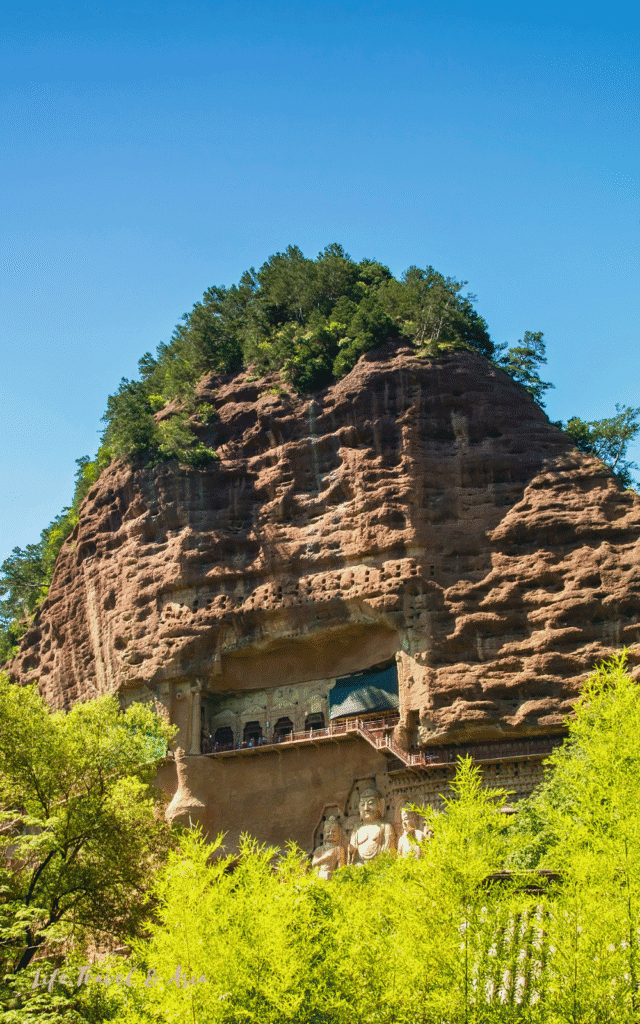
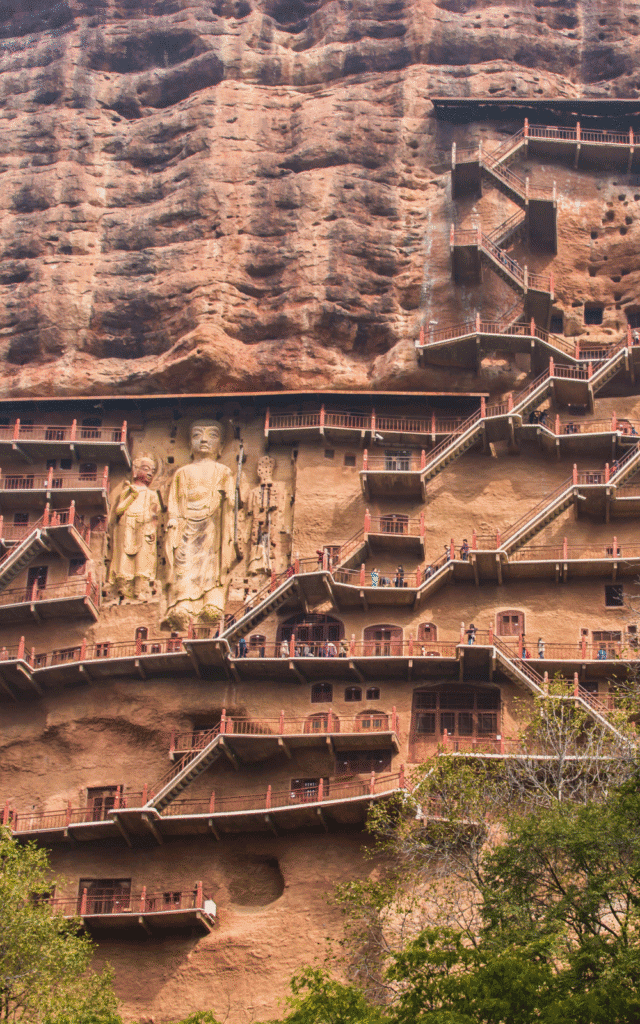
The site is built into a 142-meter-tall mountain and features 221 caves with more than 7,800 intricate statues and carvings. What makes Maijishan so unique is not just the art, but where it’s located.
The caves are cut high into the cliffs, and as you walk along the narrow hanging walkways, you’ll feel like you’re floating above the forest.
The whole Maijishan Scenic Area is worth taking your time to explore. You’ll find hiking trails, waterfalls, and even a few hidden temples scattered throughout the green surroundings. It’s the perfect nature-and-culture combo for a full-day trip.
3. Labrang Monastery in Xiahe
🚌 How to get there: From Lanzhou, you can take a bus to Xiahe County. It’s a four-hour journey.
Guided Tour to Labrang Monastery
Some parts of the monastery aren’t accessible unless you’re with a guide—which is actually a good thing. Having a guide not only helps you get into the restricted areas, but it also makes the experience so much more meaningful. This tour actually include the Lanzhou round-trip shuttle bus.
They can share insights about the temple’s history and symbolism, and if you happen to meet any monks, your guide might be able to translate their words.
At nearly 3,000 meters above sea level, the monastic town of Xiahe has grown around the impressive Labrang Monastery.
If you’re craving a peaceful and spiritual escape, this is the place. You can take your time exploring both the monastery and the surrounding mountains.
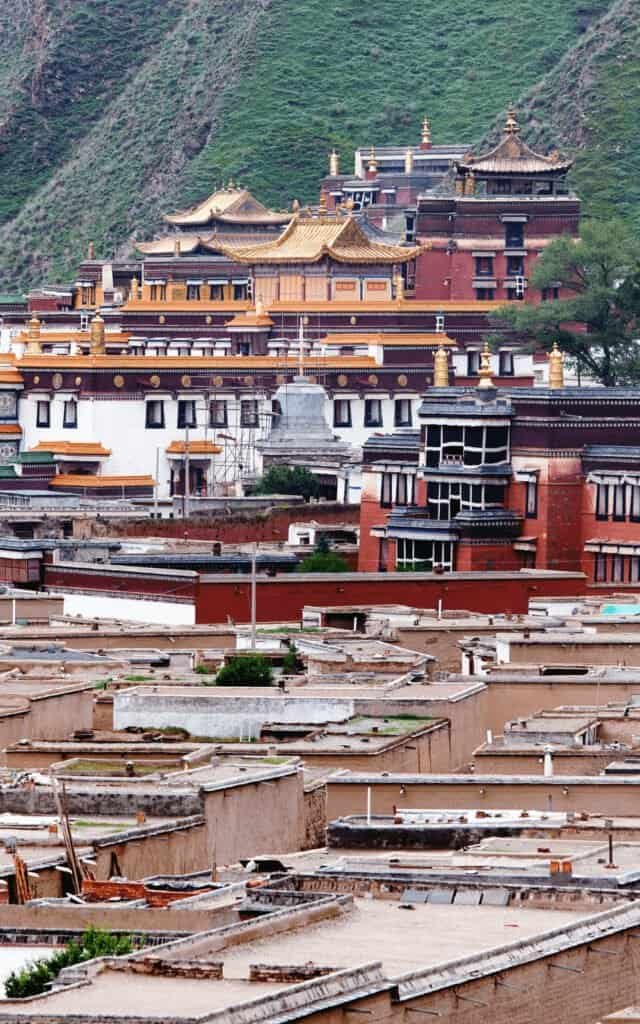
Labrang is actually the most important Tibetan monastery outside of Tibet, and you’ll feel the weight of its spiritual energy as you wander past golden-roofed temples, monastic colleges, and prayer halls.
Some areas, like the main prayer hall where monks gather to chant, can only be visited with a guide, but it’s absolutely worth it.
Don’t miss the Manjushri Temple, the Institute of Medicine, and the Golden Temple (Serkung). Just keep in mind: no photos are allowed in most of the halls, but that only adds to the sacred vibe.
There you go, hopefully this Gansu travel guide helps you plan your adventurous itinerary.
This is definitely not the easiest part of China to travel to. Still, it’s definitely worth it if you’re looking for an authentic experience (and also if you’re tired of futuristic cities and want to see something different).
If you’re looking for more support before your trip, check out my guide on navigating the language barrier in China (especially useful in Gansu) and the essential applications you should have on your phone.
And hey, if you have any questions about traveling to Gansu or China in general, drop them in the comments. I’m happy to help!
Did you find it helpful? 📌 Save it on Pinterest!
